List of Local Nature Reserves in Essex
Essex is a county in the east of England.[1] It is bounded by Suffolk and Cambridgeshire to the north, Hertfordshire to the west, Greater London to the south-west, Kent across the River Thames to the south, and the North Sea to the east.[2] It has an area of 1,420 square miles (3,700 km2), with a coastline of 400 miles (640 km),[3] and a population according to the 2011 census of 1,393,600.[4] At the top level of local government are Essex County Council and two unitary authorities, Southend-on-Sea and Thurrock. Under the county council, there are twelve district and borough councils.[5]
Local Nature Reserves (LNRs) are designated by local authorities under the National Parks and Access to the Countryside Act 1949. The local authority must have a legal control over the site, by owning or leasing it or having an agreement with the owner. LNRs are sites which have a special local interest either biologically or geologically, and local authorities have a duty to care for them. They can apply local bye-laws to manage and protect LNRs.[6][7]
As of August 2016 there are forty-nine Local Nature Reserves in Essex. Nine are also Sites of Special Scientific Interest (SSSI), three are also Scheduled Monuments and four are managed by the Essex Wildlife Trust. The largest is Southend-on-Sea Foreshore with 1,084 hectares (2,680 acres), which is part of the Benfleet and Southend Marshes SSSI, an internationally important site for migrating birds.[8] The smallest is Nazeing Triangle at 0.5 hectares (1.2 acres), which is a small pond and wildflower meadows surrounded on all three sides by roads.[9]
Key
Access
|
Other classifications
|
Sites
| Site | Photograph | Area[lower-alpha 1] | Location[lower-alpha 2] | Public access | Other classifications | Map[lower-alpha 3] | Details[lower-alpha 4] | Description |
|---|---|---|---|---|---|---|---|---|
| Belfairs | _-_geograph.org.uk_-_1770279.jpg) |
37.1 hectares (92 acres) | Leigh-on-Sea 51°33′38″N 0°37′27″E / 51.5606°N 0.62422°E TQ820879 |
Yes | EWT, [11] SSSI[12] | Map | Details | This is a small remnant of the ancient Hadleigh Great Wood. It is coppiced oak woodland on sands, gravels and clay, and one of the largest areas of old woodland in the south of the county. Bramble and honeysuckle are the main ground plants. Other plants include the rare broad-leaved helleborine.[12] |
| Belton Hills |  |
22.0 hectares (54 acres) | Leigh-on-Sea 51°32′32″N 0°38′20″E / 51.5423°N 0.6390°E TQ831859 |
Yes | Map | Details | This steeply sloping site has large areas of scrub, and there are some rare plant and invertebrates species. Plants include Deptford pink and bithynian vetch, and a survey in 2001 recorded 667 invertebrate taxa.[13] | |
| Bocking Blackwater |  |
13.1 hectares (32 acres) | Braintree 51°53′15″N 0°33′53″E / 51.8875°N 0.56474°E TL766241 |
Yes | Map | Details | The site is a long narrow strip along the south bank of the River Blackwater between Bradford Bridge and the A131 road. It has a wide variety of plant species, including veteran trees, and its habitats are wetland, woodland, scrub, wildflower meadows and grassland.[14] | |
| Brickfield and Long Meadow |  |
3.9 hectares (9.6 acres) | Earls Colne 51°55′26″N 0°42′02″E / 51.9240°N 0.70064°E TL858285 |
Yes | Map | Details | The site is described by Natural England as "a very important place for plants and insects". It has hundreds of yellow ant anthills, and many species of butterfly. Common plant include yarrow, birdsfoot trefoil, knapweed and ox-eye daisy.[15] | |
| Brockwell Meadows |  |
4.3 hectares (11 acres) | Kelvedon 51°50′02″N 0°42′19″E / 51.8340°N 0.7054°E TL865185 |
Yes | Map | Details | This site has water meadow, woodland, a pond and hedgerows. The River Blackwater runs along the eastern boundary.[16] | |
| Bull Meadow | 1.4 hectares (3.5 acres) | Colchester 51°53′45″N 0°54′25″E / 51.8957°N 0.90681°E TM001259 |
Yes | Map | Details | The meadow is unimproved damp grassland on the bank of the River Colne, with plants such as purple loosestrife and amphibious bistort. In drier areas there are great willowherb, creeping thistle and stinging nettles. There are many species of butterflies and spiders, and birds include warblers.[17] | ||
| Canvey Lake | 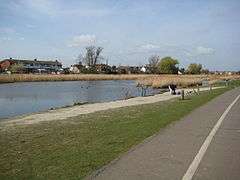 |
8.3 hectares (21 acres) | Canvey Island 51°31′38″N 0°35′08″E / 51.5273°N 0.58542°E TQ794841 |
Yes | Map | Details | The site was formerly a creek which has been converted to a lake by the building of a sea wall. Wildlife includes mallards, moorhens and water voles. A shingle bank has been created and reed beds cut back.[18] | |
| Chelmer Valley Riverside |  |
17.6 hectares (43 acres) | Chelmsford 51°44′31″N 0°28′31″E / 51.7419°N 0.47536°E TL710077 |
Yes | Map | Details | The site stretches along the River Chelmer and its banks. The northern end has the river, unimproved grassland, veteran hedges, scrub and woodland. The southern area is more managed, with mown grass as well as large trees and an area of marshland.[19] | |
| Chigwell Row Wood | 14.1 hectares (35 acres) | Chigwell 51°37′01″N 0°06′27″E / 51.6169°N 0.10741°E TQ460930 |
Yes | Map | Details | The wood is a remnant of the ancient Hainault Forest, and its history can be traced back to the seventeenth century. The trees were traditionally pollarded for fuel, and 366 pollards over 250 years old have been recorded, out of which 75% are hornbeam and 20% oak.[20] There are over 800 species of invertebrates.[21] | ||
| Church Lane Flood Meadow |  |
3.3 hectares (8.2 acres) | North Weald Bassett 51°43′16″N 0°09′41″E / 51.7211°N 0.16148°E TL494047 |
FP | Map | Details | The site was designed to relieve flooding in the parish, and it is managed for wildlife. A pond and wet grassland have been created, and over 2,500 native deciduous trees have been planted. Plants include ragged robin and marsh cinquefoil, and 16 butterfly and moth species have been recorded, together with 10 dragonflies and 60 birds.[22] | |
| Colne |  |
34.7 hectares (86 acres) | Wivenhoe 51°52′06″N 0°57′16″E / 51.8684°N 0.95445°E TM035230 |
Yes | Map | Details | This site has several different habitats, including Wivenhoe Marsh, which is adjacent to the River Colne, Wivenhoe Woods, which have sixteen tree species with sweet chestnut dominant, and Lower Lodge, scrub and grassland which has a row of mature oak trees on its eastern boundary.[23] | |
| Colne Valley |  |
5.1 hectares (13 acres) | Earls Colne 51°55′55″N 0°42′35″E / 51.9319°N 0.70984°E TL864294 |
Yes | Map | Details | The site is a linear strip along the route of the former Colne Valley and Halstead Railway, which has been converted to wildflower meadows. There are otters, bats, stag beetles and birds.[24][25] | |
| Cuckoo Wood |  |
2.5 hectares (6.2 acres) | Braintree 51°51′41″N 0°31′11″E / 51.8615°N 0.51969°E TL736211 |
NO | Map | Details | The site has amenity grassland, meadows, woods, lakes, ponds, ditches and hedgerows. It has some locally rare species, and is described by Natural England as a very good habitat for fungi, due to a large amount of dead wood.[26] | |
| Fenn Washland |  |
4.9 hectares (12 acres) | South Woodham Ferrers 51°38′15″N 0°36′30″E / 51.6374°N 0.60842°E TQ806964 |
Yes | Map | Details | The site is undeveloped wetland in a valley surrounded by housing. It has grassland, swamp, scrub, ponds and reedbed, providing diverse habitats for wildlife.[27][28] | |
| Galleywood Common |  |
44.6 hectares (110 acres) | Chelmsford 51°41′34″N 0°27′45″E / 51.6927°N 0.46255°E TL703022 |
Yes | Map | Details | Galleywood Common was recorded in the Domesday Book. Its diverse habitats include heathland, woodland, scrub, grassland, ponds and mire. It has a wide variety of fauna.[29] | |
| Gosfield Sandpits |  |
8.3 hectares (21 acres) | Braintree 51°56′07″N 0°35′48″E / 51.9353°N 0.59657°E TL786295 |
Yes | Map | Details | The site is an area of former sandpits which has around a mile of footpaths, woodland, an open glade and many ponds. There is a wide variety of trees, and flowers include wood anemones and bluebells. It is described by Natural England as "an area of outstanding natural beauty".[30][31] | |
| Grove House Wood | 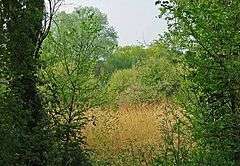 |
2.2 hectares (5.4 acres) | Stanford-le-Hope 51°30′38″N 0°25′39″E / 51.5106°N 0.427633°E TQ685818 |
Yes | Map | Details | The site has woodland with dead elms which provide nesting sites for woodpeckers. Other habitats are a pond, a brook and reedbeds.[32] | |
| Harlow Marsh |  |
13.8 hectares (34 acres) | Harlow 51°47′06″N 0°06′18″E / 51.7851°N 0.10509°E TL453117 |
Yes | SM[33] | Map | Details | This site is in three separate areas. Parndon Moat Marsh has a moat which is a Scheduled Monument, wildflower meadows and woodland.[34] Maymeads Marsh has wildflower meadows and a reed-filled pond with a bird hide,[35] and Marshgate Spring has marshes with reed and sedge beds.[36] |
| Hawkenbury Meadow |  |
1.6 hectares (4.0 acres) | Harlow 51°45′34″N 0°04′35″E / 51.7595°N 0.076369°E TL434088 |
Yes | Map | Details | The site is neutral grassland with a brook running through it. It has a variety of wild flowers including yellow rattle, common spotted orchid, cowslip, wild carrot and grass vetchling. There are strips of mature woodland along the margins, and a stand of willow trees. A damper area in the north of the site has marshland plants.[37] | |
| Hilly Fields |  |
37.5 hectares (93 acres) | Colchester 51°53′33″N 0°53′11″E / 51.8926°N 0.88626°E TL987255 |
Yes | SM[38] | Map | Details | The site has diverse habitats of grassland, woods, hedges, scrub, ponds and marsh. The grassland is grazed by rabbits, and invertebrates include minotaur beetles and bee wolf wasps. The woodland is mainly oak, ash and hawthorn, and the pond banks have reedmace and reed sweet-grass.[39] |
| Hockley Woods |  |
91.5 hectares (226 acres) | Hockley 51°35′43″N 0°38′42″E / 51.5952°N 0.64498°E TQ833918 |
Yes | SSSI[40] | Map | Details | The woods are on pre-glacial gravels and clay, with trees including hornbeam, pedunculate oak, sessile oak, birch and hazel. Ground flora include three species of orchid, and there is a stream and area of bog.[40] |
| Holland Haven |  |
22.1 hectares (55 acres) | Clacton-on-Sea 51°48′43″N 1°13′09″E / 51.8120°N 1.2192°E TM220175 |
Yes | SSSI[41] | Map | Details | This is a country park which has ponds, a scrape area, grassland, marsh and hawthorn scrub. Over 200 bird species have been recorded, including purple sandpipers, avocets and short-eared owls. There is a bird hide, car parking and toilets.[42] |
| Home Mead |  |
1.8 hectares (4.4 acres) | Loughton 51°39′38″N 0°04′45″E / 51.66057°N 0.079071°E TQ439978 |
Yes | Map | Details | This site has woodland, scrub and acid grassland. A wildflower meadow has yellow tormentil and blue bugle, both of which provide food for butterflies. Plants in the scrub area include bird's-foot trefoil and ragged robin.[43] | |
| Hoppit Mead |  |
9.2 hectares (23 acres) | Braintree 51°52′13″N 0°32′39″E / 51.8703°N 0.54416°E TL752221 |
Yes | Map | Details | This linear site has formal park areas, wildflower meadows, scrub, wet woodland and coppice. The River Brain runs through it. The seventeenth century naturalist John Ray made pioneering observations of wild blackcurrant bushes in the wet woodland.[44] | |
| Hutton Country Park | 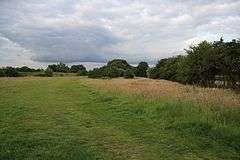 |
37.4 hectares (92 acres) | Brentwood 51°38′14″N 0°21′46″E / 51.6372°N 0.36271°E TQ636958 |
Yes | Map | Details | Most of the site is semi-natural grassland which has a diverse range of species. There are also areas of oak and hornbeam woodland, ponds and wetlands. There are birds such as moorhens and long-tailed tits, insects including large red damselflies and orange tip butterflies, and flowers such as the lesser stitchwort and ox-eye daisy.[45] | |
| Kendal Park |  |
2.8 hectares (6.9 acres) | Hullbridge 51°37′42″N 0°36′39″E / 51.62836°N 0.61079°E TQ808954 |
Yes | Map | Details | The site has a wildlflower meadow, coppiced woodland, grassland and a pond. Flowers in the meadow include hoary cress, charlock and ox-eye daisy, and there are many species of butterflies. The woodland has birds such as dunnock and song thrushes.[46] | |
| Lexden Park |  |
8.1 hectares (20 acres) | Colchester 51°53′19″N 0°51′51″E / 51.8887°N 0.86421°E TL972250 |
PP | Map | Details | The site has grassland with a wide variety of plant species such as lady's bedstraw, lesser stitchwort and greater bird's-foot-trefoil. There is also oak woodland and an ornamental lake with wildfowl.[47] | |
| Linder's Field | 3.9 hectares (9.6 acres) | Buckhurst Hill 51°37′52″N 0°02′38″E / 51.6311°N 0.043921°E TQ415944 |
Yes | Map | Details | The site has ancient woodland, scrub, grassland and ponds. The ponds have frogs, toads and newts, and bats forage in the hedgerows. Plants include bluebells and wood anemone.[48] It also has a wildflower meadow which is an important habitat for many species of invertebrates, birds and mammals.[49] | ||
| Linford Wood | 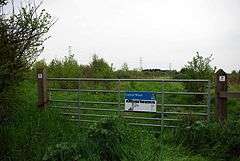 |
3.5 hectares (8.6 acres) | East Tilbury 51°29′26″N 0°24′46″E / 51.4905°N 0.412738°E TQ676796 |
Yes | Map | Details | The site has mixed woodland, a willow plantation, hedges, ditches and an open area. Birds include tawny owls, great spotted woodpeckers and green woodpeckers.[50] It is part of the proposed extended Thurrock Thameside Nature Park.[51] | |
| Magnolia Fields | 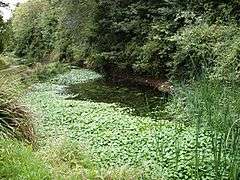 |
9.7 hectares (24 acres) | Rochford 51°35′56″N 0°41′10″E / 51.5989°N 0.68601°E TQ861923 |
Yes | Map | Details | The site is a former brickworks and evidence of its former activity is still visible, including a pond. There is a wide variety of birds, including bullfinches.[52] | |
| Marylands |  |
3.7 hectares (9.1 acres) | Hockley 51°36′31″N 0°39′16″E / 51.6085°N 0.65442°E TQ839933 |
Yes | Map | Details | The site has a varied fauna and flora, with 96 species of trees, shrubs, grasses and herbs, and 13 of butterflies. Nine of the tree species are associated with ancient woodland. There are woodland and farmland birds, and a stream with sticklebacks.[53] | |
| Mill Meadows, Billericay |  |
36.8 hectares (91 acres) | Billericay 51°37′11″N 0°25′26″E / 51.6198°N 0.42392°E TQ679940 |
Yes | SSSI[54] | Map | Details | This site has grassland, scrub and woodland, with mammals including badgers, stoats and foxes, and many bird species. Some areas are wet, and the main grasses are red fescue and common bent. Flowers include harebell and common spotted orchid.[54] |
| Nazeing Triangle |  |
0.5 hectares (1.2 acres) | Harlow 51°44′23″N 0°02′49″E / 51.7398°N 0.046925°E TL414065 |
Yes | Map | Details | This very small site, which surrounded on all three sides by roads, is mainly occupied by a pond, which has great crested and smooth newts, together with waterfowl and dragonflies. It has an area of wildflower meadow with ox-eye daisy, bird's foot trefoil and self heal. The site is bordered by a hawthorn hedge.[9] | |
| Norsey Wood |  |
65.6 hectares (162 acres) | Billericay 51°37′56″N 0°26′10″E / 51.6321°N 0.43614°E TQ687954 |
Yes | SM,[55] SSSI[56] | Map | Details | This is ancient oak woodland on acid soil which has been converted to mixed sweet chestnut coppice. There are sphagnum mosses in acidic flushes, and the rare water violet in one of the four ponds. There are nine species of dragonfly.[56] Archaeological features include a Bronze Age bowl barrow.[55] |
| Parndon Woods and Common | 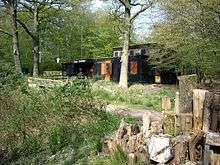 |
50.5 hectares (125 acres) | Harlow 51°44′29″N 0°05′29″E / 51.7413°N 0.091465°E TL445068 |
Yes | SSSI[57][58] | Map | Details | The woods are mainly pedunculate oak and hornbeam, and other trees include ash, hazel and birch. There are also some elms which are regenerating from coppice following Dutch elm disease.[57] |
| Pickers Ditch Meadow |  |
1.9 hectares (4.7 acres) | Clacton-on-Sea 51°48′37″N 1°09′32″E / 51.8102°N 1.15897°E TM178171 |
Yes | Map | Details | This is a linear site along the bank of Pickers Ditch, a tributary of Holland Brook. A footpath runs through the grassland, and hedges have been planted along the boundaries to screen the site.[59] | |
| Roding Valley Meadows | 65.2 hectares (161 acres) | Buckhurst Hill 51°37′42″N 0°03′53″E / 51.6284°N 0.0645979°E TQ430942 |
Yes | EWT,[60] SSSI[61] | Map | Details | The meadows are bordered to the south west by the River Roding. They form one of the largest areas of grassland in Essex which are traditionally managed as hay meadows, flood meadows and marshland. Plants include the largest beds in Essex of the rare brown sedge.[61] | |
| Roughtalley's Wood |  |
3.4 hectares (8.4 acres) | North Weald Bassett 51°42′41″N 0°09′14″E / 51.7114°N 0.153778°E TL489036 |
Yes | Map | Details | Part of this site is ancient woodland of hornbeam, oak and silver birch, with an understorey which is mainly hazel and hawthorn. The other part is younger woodland which has wildflower glades with bee and common spotted orchids, slow worms and grass snakes.[62] | |
| Salary Brook | 17.1 hectares (42 acres) | Colchester 51°53′09″N 0°56′38″E / 51.8858°N 0.94396°E TM027249 |
Yes | Map | Details | The site has a variety of habitats, with the brook itself, pasture, ponds and marsh. Fauna include four species of bats, water voles, lizards, nightingales and reed warblers. An area called Berrimans Pasture has over one hundred plants, particularly ones typical of unimproved damp grasslands.[63] | ||
| Shoeburyness Old Ranges |  |
6.4 hectares (16 acres) | Shoeburyness 51°31′23″N 0°46′48″E / 51.523°N 0.780°E TQ929840 |
NO | EWT,[64] SSSI[65] | Map | Details | The site has flora unique in the county, on a habitat of unimproved grassland over ancient sand dunes. There are areas of grasses and sedges, while rushes are found in damp hollows. Rabbits graze the grassland, and close cropped areas have many lichens.[66][lower-alpha 5] |
| Southend-on-Sea Foreshore |  |
1,083.9 hectares (2,678 acres) | Southend-on-Sea 51°31′12″N 0°45′11″E / 51.5199°N 0.75306°E TQ911837 |
Yes | Ramsar,[67] SPA,[68] SSSI[8] | Map | Details | The 8.5 miles (13.7 km) long stretch of coast is internationally important for migrating birds. Bar-tailed godwits nest on the salt marshes, and other birds include dunlins, teals, ringed plovers, grey plovers and turnstones.[69] |
| Spring Lane Meadows |  |
2.0 hectares (4.9 acres) | Colchester 51°53′29″N 0°51′52″E / 51.8914°N 0.86438°E TL972253 |
PP | Map | Details | The site has wildlflower meadows which are grazed by cattle. Birds include kingfishers, snipe and nightingales, and there are mammals such as otters and noctule bats.[70] | |
| Thornwood Common Flood Meadow |  |
3.0 hectares (7.4 acres) | North Weald Bassett 51°43′12″N 0°07′41″E / 51.7199°N 0.12812°E TL471045 |
Yes | Map | Details | The flood meadow was created to alleviate flooding in Thornwood village, and it is managed for nature conservation. A wetland meadow, 800 trees and a 200 metres (220 yd) hedge have been created. Flowers include ragged robin, oxeye daisy and knapweed.[71] | |
| Tiptree Parish Field |  |
2.2 hectares (5.4 acres) | Tiptree 51°48′48″N 0°45′12″E / 51.8133°N 0.75331°E TL898163 |
Yes | Map | Details | The field has acid rough grassland with young oak woodland, and a pond which was created by widening Layer Brook.[72] | |
| Vange Hill | 11.5 hectares (28 acres) | Basildon 51°33′40″N 0°28′48″E / 51.5611°N 0.479956°E TQ720876 |
Yes | Map | Details | The site has grassland and scrub woodland, surrounded by a drainage ditch. Some meadow areas are closely mown, but others are only cut annually, allowing flowers to grow provide food for bumblebees and butterflies. There are unusual plants such as pale flax.[73] | ||
| Weald Common Flood Meadows |  |
1.9 hectares (4.7 acres) | North Weald Bassett 51°42′50″N 0°10′06″E / 51.7138°N 0.16837°E TL499039 |
PP | Map | Details | The site consists of two meadows created for flood defence, and managed for biodiversity with the creation of a wet meadow, which is dominated by flowers such as cowslips and ragged robin. Newts and frogs breed in ponds and ditches, and grass snakes and common lizard bask on sunny days.[74] | |
| Welsh Wood | 3.2 hectares (7.9 acres) | Colchester 51°53′54″N 0°56′38″E / 51.8983°N 0.9438°E TM026262 |
Yes | Map | Details | Trees in this site, which is managed by rotational coppicing, include ash, hazel, sweet chestnut and the rare small leaved lime. It is carpeted by bluebells in the spring, and there are other flowers such as yellow archangel and wood anemone. Dead wood provides a habitat for stag beetle larvae.[75] | ||
| Whet Mead |  |
10.1 hectares (25 acres) | Witham 51°47′34″N 0°39′08″E / 51.7929°N 0.652189°E TL830138 |
Yes | Map | Details | Most of this former rubbish tip is grassland with many different flowering plants, and a range of butterflies, dragonflies and seed-eating birds. Mammals include wood mice, bank voles and pygmy shrews. There is also scrub and young woodland.[76][77] | |
| Wrabness | 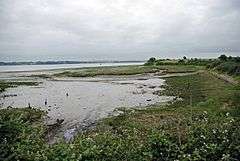 |
27.0 hectares (67 acres) | Wrabness 51°56′27″N 1°08′33″E / 51.9409°N 1.14257°E TM161316 |
Yes | EWT[78] | Map | Details | This site has grassland, marsh, scrub and woodland. It has a diverse bird life, such as yellowhammers, whitethroats, song thrushes and short-eared owls. There are also winter visitors including black-tailed godwits, grey plovers and turnstones.[78] |
See also
| Wikimedia Commons has media related to Local Nature Reserves in Essex. |
Notes
- ↑ The area is taken from the Natural England map of each site. (Click on the identify icon (i) in the "Feature Tools" and then click on the site.)
- ↑ Unless otherwise stated, the location is taken from the Natural England details page for the site.
- ↑ The maps are on the Natural England database of Local Nature Reserves.
- ↑ Details are on the pages on each site in the Natural England database of Local Nature Reserves.[10]
- ↑ The description of Shoeburyness Old Ranges is from the Foulness SSSI citation, where it is called Gunners Park.
Coordinates: 51°45′N 0°35′E / 51.750°N 0.583°E
References
- ↑ "East of England". Office for National Statistics. Retrieved 9 December 2015.
- ↑ "Essex". British Services. Retrieved 9 August 2016.
- ↑ "Essex PEEL 2015: More about this area". Her Majesty's Inspectorate of Constabulary. Retrieved 18 October 2016.
- ↑ "2011 Census (first release) Summary - Essex, districts & unitary areas". Essex Insight. Retrieved 9 August 2016.
- ↑ "Local government structure". Essex County Council. Retrieved 9 August 2016.
- ↑ "Protected or designated areas". Department for Environment, Food & Rural Affairs and Natural England. 9 April 2013. Retrieved 29 July 2015.
- ↑ "Local nature reserves: setting up and management". Department for Environment, Food & Rural Affairs and Natural England. 2 October 2014. Retrieved 29 July 2015.
- 1 2 "Benfleet and Southend Marshes citation" (PDF). Sites of Special Scientific Interest. Natural England. Retrieved 19 November 2015.
- 1 2 "Nazeing Triangle". Local Nature Reserves. Natural England. 16 March 2016. Retrieved 29 May 2016.
- ↑ "Local Nature Reserves: Search results for Essex". Natural England. Retrieved 7 October 2015.
- ↑ "Belfairs Woodland Centre". Essex Wildlife Trust. Retrieved 12 June 2016.
- 1 2 "Great Wood and Dodd's Grove citation" (PDF). Sites of Special Scientific Interest. Natural England. Retrieved 18 March 2016.
- ↑ "Site Account: Southend-on-Sea, Belton Hills". Essex Field Club. Retrieved 25 June 2016.
- ↑ "Bocking Blackwater". Local Nature Reserves. Natural England. Retrieved 22 May 2016.
- ↑ "Brickfield and Long Meadow". Local Nature Reserves. Natural England. 26 February 2013. Retrieved 22 May 2016.
- ↑ "Brockwell Meadows". Local Nature Reserves. Natural England. 26 February 2013. Retrieved 10 July 2016.
- ↑ "Bull Meadow". Colchester Borough Council. Retrieved 9 May 2016.
- ↑ "Canvey Lake". Wild Essex. Retrieved 15 August 2016.
- ↑ "Chelmer Valley Riverside". Local Nature Reserves. Natural England. 26 February 2013. Retrieved 30 July 2016.
- ↑ "Chigwell Row Wood Local Nature Reserve". Epping Forest District Council. Retrieved 11 October 2013.
- ↑ "Chigwell Row Wood". Local Nature Reserves. Natural England. 26 February 2013. Retrieved 11 October 2013.
- ↑ "Church Lane Flood Meadow Local Nature Reserve". Epping Forest District Council. Retrieved 19 June 2016.
- ↑ "Colne Local Nature Reserve". Colchester Borough Council. Retrieved 15 August 2016.
- ↑ "Colne Valley". Local Nature Reserves. Natural England. 16 January 2016. Retrieved 16 August 2016.
- ↑ "Map of Colne Valley". Local Nature Reserves. Natural England. Retrieved 16 August 2016.
- ↑ "Cuckoo Wood". Local Nature Reserves. Natural England. 26 February 2013. Retrieved 22 May 2016.
- ↑ "Fenn Washland". Local Nature Reserves. Natural England. 20 January 2016. Retrieved 25 June 2016.
- ↑ "Ch149 Fenn Washland". Essex Wildlife Trust Biological Records Centre. Retrieved 25 June 2016.
- ↑ "Galleywood Common Local Nature Reserve". Chelmsford City Council. Retrieved 16 August 2016.
- ↑ "Gosfield Sandpits, Braintree". Local Nature Reserves. Natural England. 26 February 2013. Retrieved 22 May 2016.
- ↑ "Gosfield Sandpits". Wild Essex. Retrieved 22 May 2016.
- ↑ "Grove House Wood". Local Nature Reserves. Natural England. 21 January 2016. Retrieved 16 August 2016.
- ↑ "Little Parndon moated site". Historic England. Retrieved 29 May 2016.
- ↑ "Harlow Marshes – Parndon Moat Marsh". Harlow District Council. Retrieved 29 May 2016.
- ↑ "Harlow Marshes – Maymead Marsh". Harlow District Council. Retrieved 29 May 2016.
- ↑ "Harlow Marshes – Marshgate Spring". Harlow District Council. Retrieved 29 May 2016.
- ↑ "Hawkenbury Meadow". Local Nature Reserves. Natural England. 26 February 2013. Retrieved 29 May 2016.
- ↑ "An archaeological trial-trenching evaluation at St Helena School, Sheepen Road, Colchester, Essex April 2013" (PDF). Colchester Archaeological Trust. Retrieved 16 August 2016.
- ↑ "Hilly Fields". Colchester Borough Council. Retrieved 16 August 2016.
- 1 2 "Hockley Woods citation" (PDF). Sites of Special Scientific Interest. Natural England. Retrieved 2 August 2016.
- ↑ "Holland Haven Marshes citation" (PDF). Sites of Special Scientific Interest. Natural England. Retrieved 8 June 2016.
- ↑ "Holland Haven". Local Nature Reserves. Natural England. 25 January 2016. Retrieved 8 June 2016.
- ↑ "Home Mead". Local Nature Reserves. Natural England. 25 January 2016. Retrieved 16 August 2016.
- ↑ "Hoppit Mead". Local Nature Reserves. Natural England. 29 April 2014. Retrieved 22 May 2016.
- ↑ "Hutton Country Park". Brentwood Borough Council. Retrieved 16 August 2016.
- ↑ "Kendal Park Nature Reserve". Hullbridge Parish Council. Retrieved 25 June 2016.
- ↑ "Lexden Park". Local Nature Reserves. Natural England. 28 January 2016. Retrieved 6 July 2016.
- ↑ "Linder's Field". Local Nature Reserves. Natural England. Retrieved 10 October 2013.
- ↑ "Linder's Field Local Nature Reserve". Epping Forest District Council. Retrieved 10 October 2013.
- ↑ "Linford Wood". Local Nature Reserves. Natural England. 16 March 2016. Retrieved 17 August 2016.
- ↑ "Thurrock Thameside Nature Park". The Wildlife Trusts. Retrieved 17 August 2016.
- ↑ "Magnolia Fields". Local Nature Reserves. Natural England. 11 March 2014. Retrieved 17 August 2016.
- ↑ "Marylands". Local Nature Reserves. Natural England. 16 March 2016. Retrieved 25 June 2016.
- 1 2 "Mill Meadows, Billericay citation" (PDF). Sites of Special Scientific Interest. Natural England. Retrieved 12 June 2016.
- 1 2 "Multi-period site at Norsey Wood". Historic England. Retrieved 5 August 2016.
- 1 2 "Norsey Wood citation" (PDF). Sites of Special Scientific Interest. Natural England. Retrieved 5 August 2016.
- 1 2 "Harlow Woods" (PDF). Sites of Special Scientific Interest. Natural England. Retrieved 2 January 2016.
- ↑ "Parndon Woods and Common". Local Nature Reserves. Natural England. 27 February 2013. Retrieved 2 January 2016.
- ↑ "Pickers Ditch Meadow". Local Nature Reserves. Natural England. 27 February 2013. Retrieved 9 June 2016.
- ↑ "Roding Valley Meadows". Essex Wildlife Trust. Retrieved 6 August 2016.
- 1 2 "Roding Valley Meadows citation". Sites of Special Scientific Interest. Natural England. Retrieved 6 August 2016.
- ↑ "Roughtalley's Wood Local Nature Reserve". Epping Forest District Council. Retrieved 19 June 2016.
- ↑ "Salary Brook Local Nature Reserve". Colchester Borough Council. Retrieved 11 May 2016.
- ↑ "Gunners Park and Shoebury Ranges Nature Reserve". Essex Wildlife Trust. Retrieved 10 October 2015.
- ↑ "Unit List, Foulness SSSI". Sites of Special Scientific Interest. Natural England. Retrieved 30 August 2016.
- ↑ "Foulness citation" (PDF). Sites of Special Scientific Interest. Natural England. Retrieved 30 August 2016.
- ↑ "Information Sheet on Ramsar Wetlands: Benfleet and Southend Marshes" (PDF). Joint Nature Conservation Committee. Retrieved 19 November 2015.
- ↑ "Benfleet and Southend Marshes" (PDF). Special Protection Areas under the EC Birds Directive. Joint Nature Conservation Committee. Retrieved 22 August 2016.
- ↑ "Southend-on-Sea Foreshore". Local Nature Reserves. Natural England. 16 March 2016. Retrieved 17 August 2016.
- ↑ "Spring Lane Meadows". Local Nature Reserves. Natural England. 28 January 2016. Retrieved 6 July 2016.
- ↑ "Thornwood Flood Meadow Local Nature Reserve". Epping Forest District Council. Retrieved 19 June 2016.
- ↑ "Tiptree Parish Field". Local Nature Reserves. Natural England. 27 February 2013. Retrieved 10 July 2016.
- ↑ "Vange Hill Open Space". Basildon Council. Retrieved 19 August 2016.
- ↑ "Weald Common Local Nature Reserve". Epping Forest District Council. Retrieved 19 June 2016.
- ↑ "Welsh Wood". Colchester Borough Council. Retrieved 11 May 2016.
- ↑ "Whet Mead". Local Nature Reserves. Natural England. 16 March 2016. Retrieved 11 July 2016.
- ↑ "Newsletter No 5" (PDF). The Essex Field Club. January 1993. Retrieved 11 July 2016.
- 1 2 "Wrabness Nature Reserve". Essex Wildlife Trust. Retrieved 20 August 2016.
